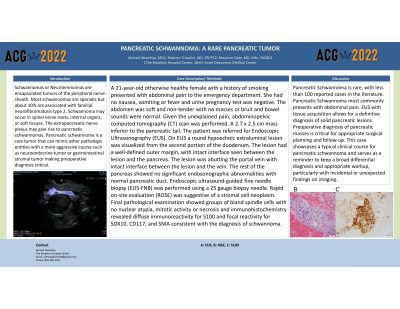Back


Poster Session C - Monday Afternoon
Category: Biliary/Pancreas
C0050 - Pancreatic Schwannoma: A Rare Pancreatic Tumor
Monday, October 24, 2022
3:00 PM – 5:00 PM ET
Location: Crown Ballroom

Has Audio

Ahmed Abomhya, MD
The Brooklyn Hospital Center
Brooklyn, NY
Presenting Author(s)
Ahmed Abomhya, MD1, Roberto Trasolini, MD2, Moamen Gabr, MD, MSc2
1The Brooklyn Hospital Center, Brooklyn, NY; 2Beth Israel Deaconess Medical Center, Boston, MA
Introduction: Schwannomas or Neurilemmomas are encapsulated tumors of the peripheral nerve sheath. Most schwannomas are sporadic but about 10% are associated with familial neurofibromatosis type 2. Schwannoma may occur in spinal nerve roots, internal organs, or soft tissues. The extrapancreatic nerve plexus may give rise to pancreatic schwannomas. Pancreatic schwannoma is a rare tumor that can mimic other pathologic entities with a more aggressive course such as neuroendocrine tumor or gastrointestinal stromal tumor making preoperative diagnosis critical.
Case Description/Methods: A 21-year-old otherwise healthy female with a history of smoking presented with abdominal pain to the emergency department. She had no nausea, vomiting or fever and urine pregnancy test was negative. The abdomen was soft and non-tender with no masses or bruit and bowel sounds were normal. Given the unexplained pain, abdominopelvic computed tomography (CT) scan was performed. A 2.7 x 2.5 cm mass inferior to the pancreatic tail. The patient was referred for Endoscopic Ultrasonography (EUS). On EUS a round hypoechoic extraluminal lesion was visualized from the second portion of the duodenum. The lesion had a well-defined outer margin, with intact interface seen between the lesion and the pancreas. The lesion was abutting the portal vein with intact interface between the lesion and the vein. The rest of the pancreas showed no significant endosonographic abnormalities with normal pancreatic duct. Endoscopic ultrasound-guided fine needle biopsy (EUS-FNB) was performed using a 25 gauge biopsy needle. Rapid on-site evaluation (ROSE) was suggestive of a stromal cell neoplasm. Final pathological examination showed groups of bland spindle cells with no nuclear atypia, mitotic activity or necrosis and immunohistochemistry revealed diffuse immunoreactivity for S100 and focal reactivity for SOX10, CD117, and SMA consistent with the diagnosis of schwannoma.
Discussion: Pancreatic Schwannoma is rare, with less than 100 reported cases in the literature. Pancreatic Schwannoma most commonly presents with abdominal pain. EUS with tissue acquisition allows for a definitive diagnosis of solid pancreatic lesions. Preoperative diagnosis of pancreatic masses is critical for appropriate surgical planning and follow-up. This case showcases a typical clinical course for pancreatic schwannoma and serves as a reminder to keep a broad differential diagnosis and appropriate workup, particularly with incidental or unexpected findings on imaging.

Disclosures:
Ahmed Abomhya, MD1, Roberto Trasolini, MD2, Moamen Gabr, MD, MSc2. C0050 - Pancreatic Schwannoma: A Rare Pancreatic Tumor, ACG 2022 Annual Scientific Meeting Abstracts. Charlotte, NC: American College of Gastroenterology.
1The Brooklyn Hospital Center, Brooklyn, NY; 2Beth Israel Deaconess Medical Center, Boston, MA
Introduction: Schwannomas or Neurilemmomas are encapsulated tumors of the peripheral nerve sheath. Most schwannomas are sporadic but about 10% are associated with familial neurofibromatosis type 2. Schwannoma may occur in spinal nerve roots, internal organs, or soft tissues. The extrapancreatic nerve plexus may give rise to pancreatic schwannomas. Pancreatic schwannoma is a rare tumor that can mimic other pathologic entities with a more aggressive course such as neuroendocrine tumor or gastrointestinal stromal tumor making preoperative diagnosis critical.
Case Description/Methods: A 21-year-old otherwise healthy female with a history of smoking presented with abdominal pain to the emergency department. She had no nausea, vomiting or fever and urine pregnancy test was negative. The abdomen was soft and non-tender with no masses or bruit and bowel sounds were normal. Given the unexplained pain, abdominopelvic computed tomography (CT) scan was performed. A 2.7 x 2.5 cm mass inferior to the pancreatic tail. The patient was referred for Endoscopic Ultrasonography (EUS). On EUS a round hypoechoic extraluminal lesion was visualized from the second portion of the duodenum. The lesion had a well-defined outer margin, with intact interface seen between the lesion and the pancreas. The lesion was abutting the portal vein with intact interface between the lesion and the vein. The rest of the pancreas showed no significant endosonographic abnormalities with normal pancreatic duct. Endoscopic ultrasound-guided fine needle biopsy (EUS-FNB) was performed using a 25 gauge biopsy needle. Rapid on-site evaluation (ROSE) was suggestive of a stromal cell neoplasm. Final pathological examination showed groups of bland spindle cells with no nuclear atypia, mitotic activity or necrosis and immunohistochemistry revealed diffuse immunoreactivity for S100 and focal reactivity for SOX10, CD117, and SMA consistent with the diagnosis of schwannoma.
Discussion: Pancreatic Schwannoma is rare, with less than 100 reported cases in the literature. Pancreatic Schwannoma most commonly presents with abdominal pain. EUS with tissue acquisition allows for a definitive diagnosis of solid pancreatic lesions. Preoperative diagnosis of pancreatic masses is critical for appropriate surgical planning and follow-up. This case showcases a typical clinical course for pancreatic schwannoma and serves as a reminder to keep a broad differential diagnosis and appropriate workup, particularly with incidental or unexpected findings on imaging.

Figure: A: EUS, B: H&E, C: S100
Disclosures:
Ahmed Abomhya indicated no relevant financial relationships.
Roberto Trasolini indicated no relevant financial relationships.
Moamen Gabr indicated no relevant financial relationships.
Ahmed Abomhya, MD1, Roberto Trasolini, MD2, Moamen Gabr, MD, MSc2. C0050 - Pancreatic Schwannoma: A Rare Pancreatic Tumor, ACG 2022 Annual Scientific Meeting Abstracts. Charlotte, NC: American College of Gastroenterology.
